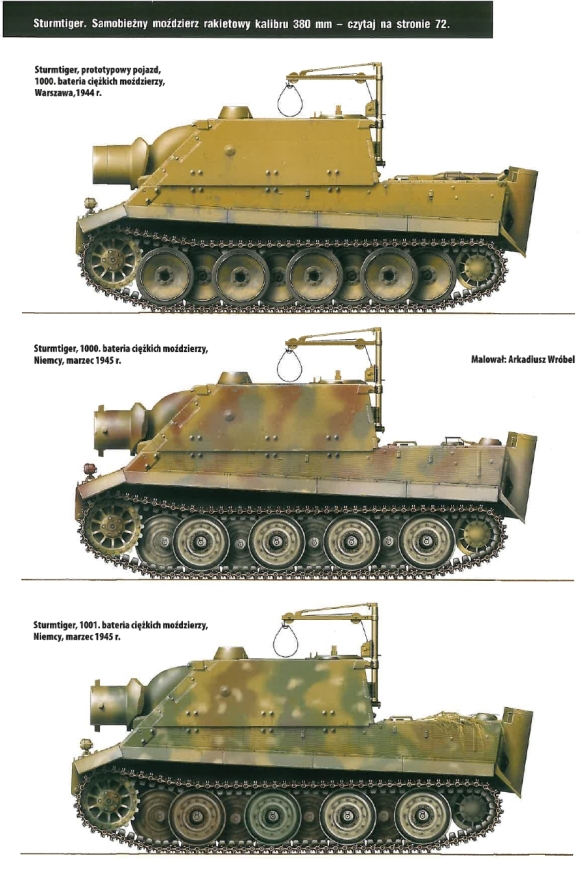Sturmtiger, designated 38 cm RW 61 Ausf Stu Mrs Tiger. This 65 ton vehicle consisted of a 38 cm Type 61 rocket projector or mortar mounted as an assault howitzer on a modified Tiger E chassis. The Raketenwerfer 61 L/54 was originally developed as an anti-submarine weapon for the German Navy
The idea for a heavy infantry support vehicle capable of demolishing heavily defended buildings or fortified areas with a single shot came out of the experiences of the heavy urban fighting in the Battle of Stalingrad in 1942.
At the time, the Wehrmacht had only the Sturm-Infanteriegeschütz 33B available for destroying buildings, a Sturmgeschütz III variant armed with a 15 cm sIG 33 heavy infantry gun. Twelve of them were lost in the fighting at Stalingrad. Its successor, the Sturmpanzer IV/Brummbär was in production from early 1943, but the Wehrmacht still saw a need for a similar, but heavier armoured and armed vehicle. Therefore a decision was made to create a new vehicle based on the Tiger tank and arm it with a 210 mm howitzer.
However, this weapon turned out not to be available at the time and was therefore replaced by a 380 mm rocket launcher, which was adapted from a Kriegsmarine depth charge launcher.
In September 1943 plans were made for Krupp to fabricate new Tiger I armored hulls for the Sturmtiger. The Tiger I hulls were to be sent to Henschel for chassis assembly and then to Alkett where the superstructures would be mounted. The first prototype was ready and presented to Adolf Hitler in October 1943. Delivery of the first hulls would occur in December 1943, with the first three Sturmtigers completed by Alkett by 20 February 1944.
Due to delays, Hitler did not request production of the weapon until 19 April 1944; 12 superstructures and weapons for the Sturmtiger would be prepared and mounted on rebuilt Tiger I chassis. The first three production series Sturmtigers were completed by Alkett in August 1944. Plans to complete an additional seven 38 cm Sturmtigers from 15 to 21 September 1944 were presented to Hitler in a conference on 18-20 August 1944. Ten Sturmtigers were produced in September, along with an additional five in December 1944.
Hitler had laid great importance on the special employment of the Sturmtiger and believed it would be necessary to produce at least 300 rounds of ammunition per month.
These vehicles were heavily armoured and were intended for mobile assault against troop concentrations and fortifications. A small crane was fitted to the rear of the vehicle to load the projectiles of which 13 were carried, including one on the loading tray of the projector. An MG 34 was ball-mounted in the offside of the superstructure front plate. Being slow, cumbersome, and of limited tactical value they played no significant part in the closing months of the war; they were to have been used in ones and twos only, and were swiftly immobilised and captured when they put in an appearance.
The original role of the Sturmtiger was intended to be as a heavy infantry support vehicle, to help with attacks on heavily fortified or built-up areas. By the time the first Sturmtigers were available however, the situation for Germany had changed for the worse, with the Wehrmacht being almost exclusively on the defensive rather than the offensive.
Three new Panzer companies were raised to operate the Sturmtiger: Panzer Sturmmörser Kompanien (PzStuMrKp) (Armored Assault Mortar Company) 1000, 1001 and 1002. These originally were supposed to be equipped with fourteen vehicles, but this figure was later reduced to four each, divided into two platoons.
PzStuMrKp 1000 was raised on 13 August 1944 and fought during the Warsaw Uprising with two vehicles, as did the prototype in a separate action, which may have been the only time the Sturmtiger was used in its intended role. PzStuMrKp 1001 (commanded by Captain von Gottberg) and 1002 (commanded by Lieutenant Zippel) followed in September and October. Both PzStuMrKp 1000 and 1001 served during the Ardennes Offensive, with a total of seven Sturmtigers.
After this offensive, the Sturmtigers were used in the defence of Germany proper, mainly on the Western front.
Frequently Asked Questions about the Sturmtiger
Were Sturmtiger munitions carried onboard?
The Sturmtiger internally carried 14 rounds of ammunition. One round loaded, one round in the loading tray, and then the other twelve rounds on two storage racks.
What ammunition did the Sturmtiger use?
The Sturmtiger would fire a variety of short-range rocket-propelled munitions, which were roughly 1.5 meters (~4.92 feet) long.
How long would it take to reload the Sturmtiger?
The reload time for a Sturmtiger was roughly 40 seconds for experienced crews. The entire reload process would take anywhere from 10 to 15 minutes per round with the crane setup and vehicle positioning, totaling over 2 hours for all 14 rounds to be reloaded.
What gun did the Sturmtiger use?
The main armament was a 380 mm Raketen-Werfer 61 L/5.4 rocket-propelled mortar with a maximum range of 6,000 meters (20,000 feet).
Reference: LINK

“The idea for a heavy infantry support vehicle capable of demolishing heavily defended buildings or fortified areas with a single shot came out of the experiences of the heavy urban fighting in the Battle of Stalingrad in 1942.”
It is an interesting “what-if” if the Sturmtiger had been available in reasonable numbers for the Battle of Stalingrad – would it have changed the course of the battle?